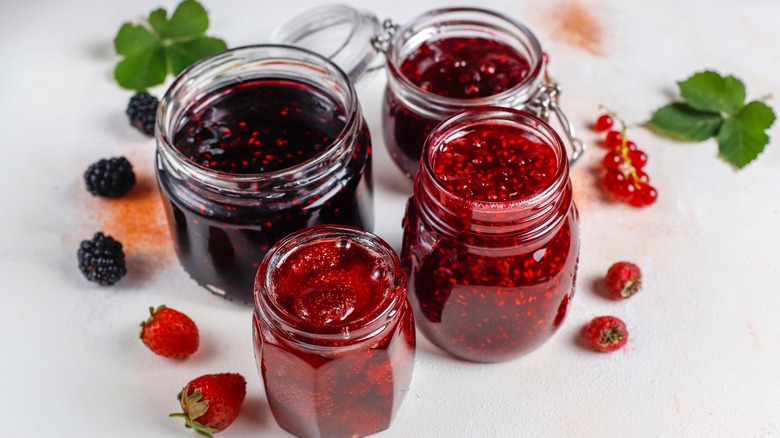What To Know Before Making Jam With Canned Fruit
Jams are an excellent way to preserve fruits for later, and the hobby of home canning has also grown in recent years as new enthusiasts have discovered the craft. If you're interested in trying your hand at making jellies but don't have any fresh fruit, then you can always substitute the ingredient. Nowhere in the canning handbooks does it say that you are beholden to only use fresh fruit. With certain concessions, most fruit will do.
Just as you can make a thick tasty jam with frozen fruit, you can also use canned fruit to make quick and easy jams as well. While you don't have to worry about canned fruit not holding up to being essentially canned twice, it's worth noting that the texture and consistency will be different from using fresh fruit. Having the wrong ratio of sugar to pectin (which we will get to in a moment) can make for a thin runny jam. That's hardly what most diners want when they're looking to slather their morning toast with something fruity. Fortunately, there are factors to keep in mind. For one, consider using canned fruits that are sugar-free or that have a very low sugar content. Over time, sugar will macerate fruits, making them soft, which can lead to a mushy jam. So be sure not to add it too early or too late in the process.
Add pectin to your recipe
Jams and jellies need pectin to thicken. Think of pectin as a natural thickener or leaven that causes your mashed fruit to become a paste rather than a syrup. The heat of the canning process activates pectin, which encloses the essence of the fruit in a jello-like cocoon. Pectin plays such an important role in jams that if your mixture lacks pectin then you're setting yourself up for disaster. Some fruits have a naturally high amount of pectin such as apples and grapes.
However, in particular, canned fruits have a lower amount of pectin than you would like for canning — for two reasons. Canned fruits are typically cooked prior to canning. Overcooking your fruit will break down and lower the amount of pectin. Likewise, canned fruits are typically made from ripened or over-ripened fruit. As such, it has low pectin levels.
Fortunately, it's fairly easy to add pectin to your fruit. There's readily available commercial pectin on the market in both liquid and powder form. Just add a few teaspoons of pectin to your jam to turn it from runny to thick. Consider these other tips as well.
Other tips for making jams
If you add too much pectin, then you may be stuck with a gelatinous mess that's too thick. While pectin will help thicken your jams, pectin is just one factor to consider when considering the viscosity of jam. The cooking time of the mixture also plays a role, and it's especially important to consider in canned fruits since the fruit's already been cooked once over. Cook your jams too long, then you run the risk of making them runny because you'll effectively cook out all the pectin. Likewise, you want to be sure that you are cooking at a high enough temperature (about 220 degrees F) to trigger the pectin's effects.
The acidity of your jam also plays a role, so consider incorporating a citrus or another acid if you're working with a fruit that has a low natural acidity. Finally, as mentioned above, you should avoid using canned fruits that have been covered in artificial sugar. However, you want to avoid not having enough sugar in your jam as well as that can affect the final thickness of your jams as well. It's a balancing act so you may need to add some sugar to the mix.


